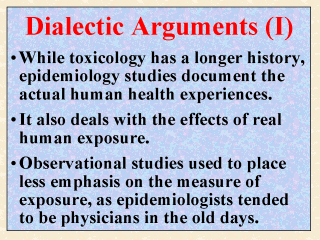| front |1 |2 |3 |4 |5 |6 |7 |8 |9 |10 |11 |12 |13 |14 |15 |16 |17 |18 |19 |20 |21 |review |
 |
Earlier in this
series (Lectures 3 and 4),
the close linkage between toxicology and epidemiology in health risk assessment (RA) was
discussed and demonstrated extensively. That discussion was based largely upon some
opportunistic cases or references with little dialectic elaboration. It is time now to
provide some logical arguments offered by other (presumably more knowledgeable) scientists
in the two disciplines. The intent here is to present an overview of how some
epidemiologists and toxicologists look up or down at one another in terms of their
profession's contribution to RA. In discussing the role of epidemiology in toxicology, Tomenson and Brown (1993) revealed a longer historical root of toxicology. They further noticed that "Despite the lack of precise data, the epidemiologist has one major advantage over the toxicologist: an epidemiology study documents the actual health experiences of human beings subjected to real-life exposures in an occupational or environmental setting." Their view was shared by Cook (2001) recently, who reassured that epidemiologic studies "deals with the effects of real (human) exposures." Tomenson and Brown also restated the belief by Wegman and Eisen (1988) that those that conduct observational studies are primarily physicians, and hence epidemiology has placed less emphasis on the measure of exposure. Apparently this argument is no longer valid, since nowadays more and more epidemiology doctorates are without a medical degree. |